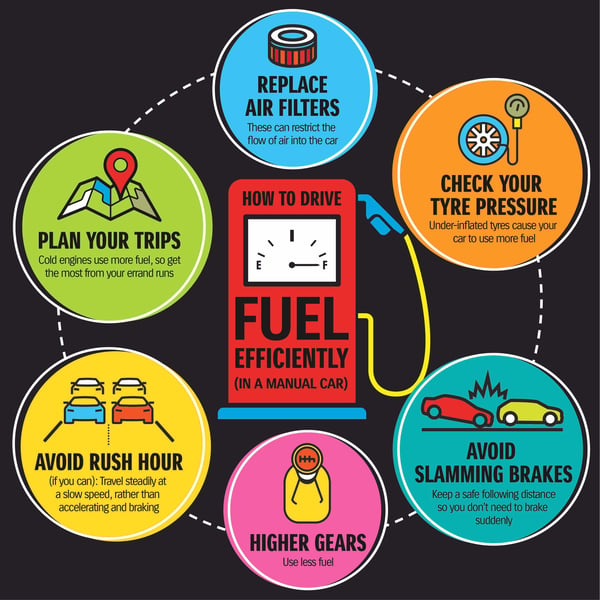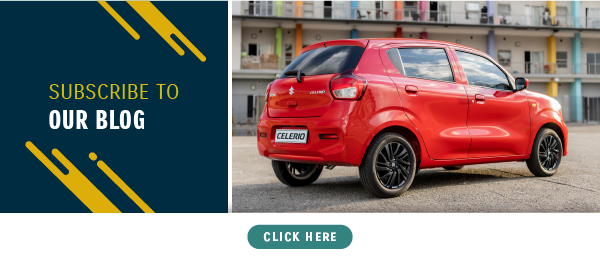With the price of both petrol and diesel expected to continue to rise, driving in a fuel-efficient manner is now a necessity for most commuters and there are several ways in which drivers can eke out more mileage from their manual cars.
The simplest and most effective way to save fuel is - don’t drive!
By this we mean all trips should be carefully pre-planned and made only when necessary. When you drive a car that has been parked for a few hours, the engine is cold and uses much more fuel for the first 10 kilometres or so. Ideally, combine all your daily errands into one single round trip.
Traffic is a huge fuel demon for manual cars and there are some tricks to ease this. If your car is equipped with a Stop/Start function, ensure it is switched on. The manufacturer has designed the car for this function and its own fuel efficiency efforts on your behalf which means you will save more than allowing the engine to idle.
Obviously, the best solution is to not travel during the rush hour. You can also save some fuel by trying to understand what the traffic is doing in front of you and travelling steadily at a slow speed, rather than accelerating and braking.
If you are stationary in traffic and you do not have the stop/start function, pull up the handbrake and engage neutral. Keeping your foot on the brake is tiring and worse, riding the clutch simply eats up fuel to say nothing about the damage it causes...
Once you do start to move shift up to the highest gear possible as quickly as you can. The perfect way to travel is at a constant speed and in the highest gear. So if you are a patient driver, you will have lower fuel bills – it is as simple as that. It is unrealistic to avoid overtaking, but there is little point accelerating past a car to simply be in front of it at the next set of lights – any instant gratification will appear on your fuel bill the next time you fill up.
Also, do not push the accelerator down too far. You may be in a high gear and travelling at a sensible speed, but if you are pushing the accelerator down a long way to avoid changing into a lower gear (into third from fourth, for example), then you are actually using more fuel not less.
If you tail a vehicle too closely, then you tend to slam the brakes abruptly, which brings your vehicle to a screeching halt. This means, when you have to start up again, you will pump more fuel into the engine.
Keep a proper distance from the car in front of you so you can time it and you can just coast along behind them. The moment they accelerate, you will just need to lightly step on the throttle to maintain speed or increase speed a little. This is a more fuel-efficient way to travel.
There is a reason your car manufacturer specifies a definite pressure for your tyres. For more efficient fuel consumption, manufacturers usually recommend a pressure and, although the ride can become a bit rougher, correct tyre pressure decreases road resistance which, in turn, decreases energy loss. Lower resistance means there is no need to keep putting pressure on your pedal for more power.
Under-inflated tyres are one of the most commonly ignored causes of crummy fuel consumption. Tyres lose air due to time (about 1 psi per month) and temperature (1 psi for every 10-degree drop). Under-inflated tyres have more rolling resistance, which means your engine has to work harder to keep your car moving.
Be sure to check your tyres regularly and do it when they are cold, since driving the car warms up the tyres (and the air inside them), which increases pressure and gives a falsely high reading.
Another item that deserves – but rarely gets – regular checking is the air filter. A dirty air filter restricts the flow of air into the engine, which harms performance and economy. Air filters are easy to check and change and the owner's manual will provide the instructions. Remove the filter and hold it up to the sun – if you cannot see light coming through it, you need a new one.
Quick Tips
1. Close the windows (and sunroof, if you have one)
When you on the motorway and moving more quickly, the shape of your car is very important. Car designers call it aerodynamics and make lots of effort to reduce the 'drag' to make the car as sleek as possible. Anything that makes wind noise as your car goes along is actually making your car more expensive to run.
2. Remove the roof rack
This is just like leaving the windows open, but worse. Even if the roof rack is empty, it increases drag and makes your car use more fuel. The latest roof racks are quick and easy to fit and remove, so stow them away when you are not using them.
3. Unnecessary weight
Just like your body, your car needs more fuel to move around more weight. So, do not cart stuff around in the boot of your car unless you need it.
4. Turn off the air-conditioning
Long hot summers are a wonderful part of South African life, except when you are on the road. While it might be tempting to leave the air-conditioning on, it uses quite a bit of fuel, so turn it off when it is not hot or the car has cooled to a comfortable temperature.
5. Stick to the speed limit
Driving faster to shorten the journey time is a false economy – while you might save a few minutes, the higher speed equals higher fuel consumption, in turn meaning more money spent at the pumps (and maybe in the courts if you get caught for speeding). You will possibly save 20 minutes over 320 km travelling at an average 128 km/h instead of 112 km/h but the additional fuel could be as much as R120.
How to drive fuel efficiently (in a manual car)

- Plan your trips: Cold engines use more fuel, so get the most from your errand runs.
- Avoid rush hour (if you can): travel steadily at a slow speed, rather than accelerating and braking.
- Avoid slamming on the brakes: Keep a safe following distance so you don’t need to brake suddenly.
- Higher gears use less fuel.
- Check your tyre pressure: under-inflated tyres cause your car to use more fuel.
- Replace your air filters: these can restrict the flow of air into the car.
Follow these simple tricks to drive more fuel efficiently - especially as the fuel price keeps increasing.
Now that you know more about driving and saving fuel in a manual vehicle, you may want to share how to save fuel in an automatic vehicle. Better yet, you could subscribe to our weekly or monthly blog to get these interesting updates straight into your inbox.

![What will I spend on fuel with the changing fuel price? [Calculator]](https://blog.suzukiauto.co.za/hubfs/featured-1.png)

![10 tricks to save you fuel when driving an automatic car [UPDATED]](https://blog.suzukiauto.co.za/hubfs/Swift%20MC%202021/Suzuki%20Swift%202021%20-%20124%20_%20Resized.png)